Hole in the Clouds
Sep 8, 2009
In the summer of 1913, Hazel Reiber winds up for a pitch near the ocean in the big sandlot at Long Beach, Long Island. Her bathing costume looks skimpier than the outfits many women wore back then, but her boots would do just fine for a professional wrestler.
That is a baseball in her right hand, but I'm guessing--hoping--that the person she's throwing to is not swinging a bat. It doesn't look safe for slugging thereabouts.
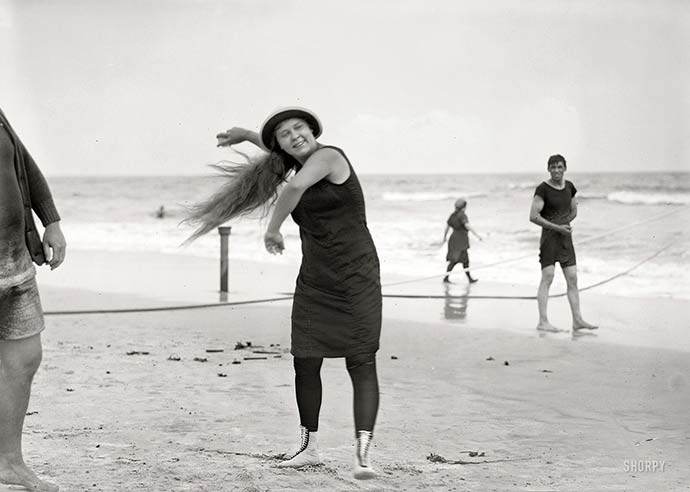
sports
New York
vintage
Long Island
beach
baseball
Hazel Reiber
(Image credit: Bain News Service, shorpy.com)
Oct 3, 2009
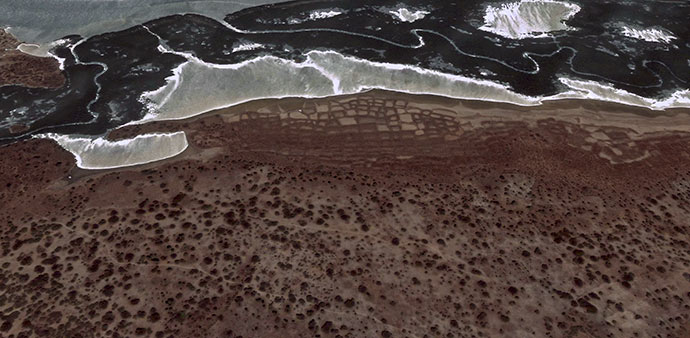
The Atlantic coast of Senegal near the mouth of the Gambia River, as perceived by the sensors of the Landsat 7 satellite.
landscape
beach
Senegal
birdseye
Atlantic
(Image credit: NASA Landsat 7)
Dec 26, 2009
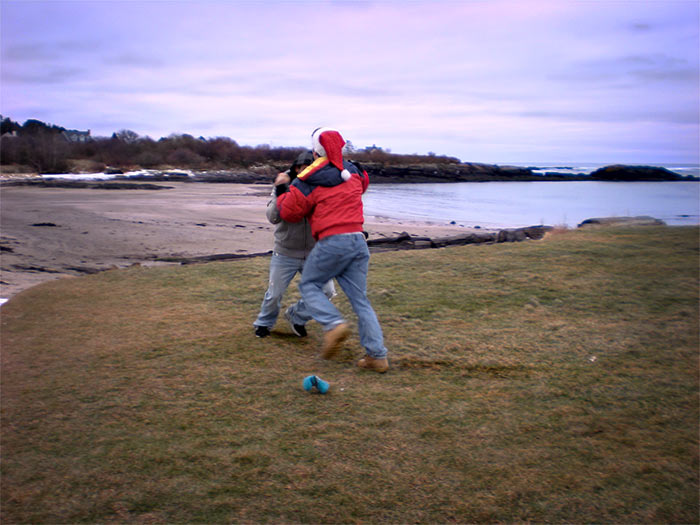
To be more precise: at least one mitten came off late in the afternoon of Christmas day when Hank and Al had at it on the bluff above Kettle Cove, on the nearly snowless southern coast of Maine. It wasn't a real fight, just a little sibling rasslery.
beach
Maine
wrestling
Allen Stein
Hank Stein
winter
Kettle Cove
Scarborough
(Image credit: Ellen Stein)
Jun 26, 2010

We have all seen pictures of the oil gusher in the Gulf of Mexico; this is the one that put a catch in my breath today.
Nicole Kesterson of Gulf Shores, Alabama, is snapping a picture at the public beach near Gulf Shores State Park, while blackened surf splashes down onto the sand. Used to be, Gulf Shores and nearby beaches were characterized by what people called "sugar sand"--fine, white, perfect, clean quartz crystalline sand. I've seen tarballs there before--Gulf oil platforms are visible from many parts of the beach--but black waves of crude are something else again.
Picture these gentle little waves roughed up and built into mountains by a hurricane--Atlantic and Gulf waters are warmer this summer than ever before in human history, and hurricanes are the earth's major mechanism for dealing with hot spots of subtropical water. The oil will come crashing inland, obviously, surging for miles to flood uncleanable marshes and swamps. And evidence is accumulating that thanks to BP's massive use of dispersants, oil will also likely be sucked up into the sky; oil vapor will gather in the clouds along with water vapor to rain poison down on us all.
For what it's worth, the good news is that mosquitoes don't do well in oily environments.
I have spent enough time among geologists to accept that all substantial reservoirs of oil on the planet will eventually be tapped for human use. But what I hear about energy policy in America these days seems completely backwards to me: why aren't we letting the Saudis and the Russians let their wells run dry before we tap into our own precious reserves? Countries with no other source of income or with desperate economic problems have no choice but to sell off all their oil as quickly as possible. We're rich enough to wait for a while, and as the rest of the world's oil disappears, ours becomes more and more valuable. Perhaps eventually it will be worth so much that oil companies will be cautious not to risk spilling a drop.
Or whatever.
Alabama
beach
Nicole Kesterson
BP
oil
Gulf Shores
(Image credit: John David Mercer of the Mobile Press-Register)
Jul 26, 2010
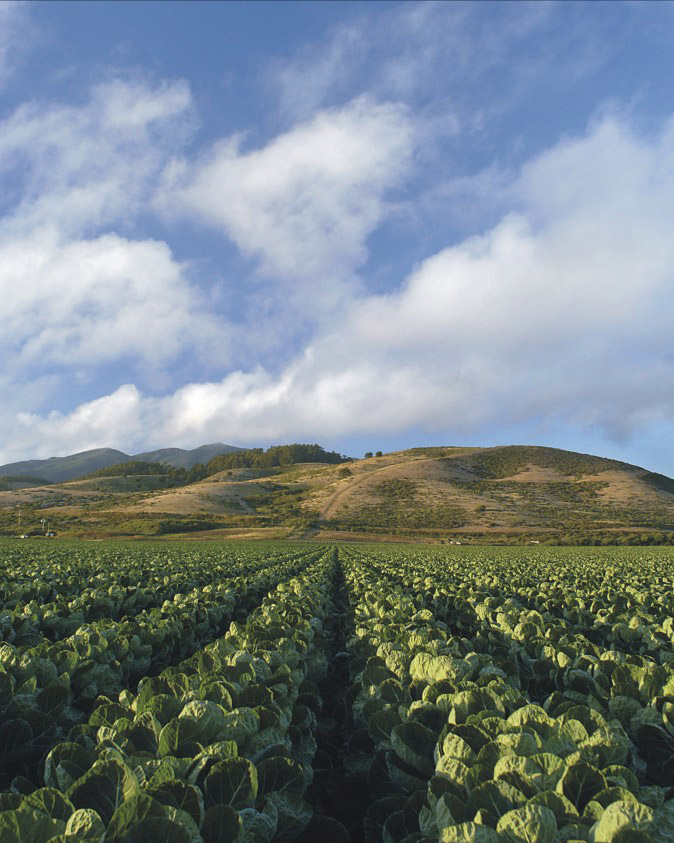
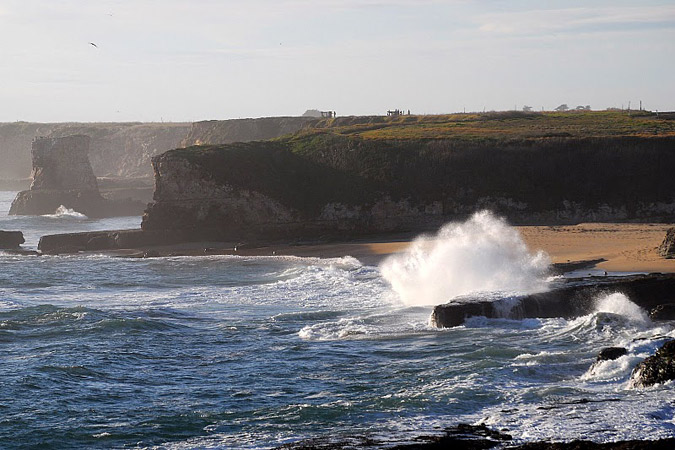
It was a while ago, close to fifteen years ago, but I think I remember how to get there: walk down the hill and through the fields of brussels sprouts to the edge of the cliffs above the sea. Follow the clifftops for a mile or so, till a narrow squiggly trail branches off the main track and maneuvers down through a gully in the cliff face. Scramble down to the bottom, and there you are, in the sandy little cove, sharing your beach with the ocean and the sky.
I hope I remember this place right. It seemed memorable for three reasons: the seclusion of the cove, the scenery surrounding the walk to the cove, and the brussels sprouts. The beach is in Wilder Ranch State Park near Santa Cruz, California. And for what it's worth, almost all of America's brussels sprouts are grown right there along the Pacific coast of Santa Cruz County, where winters are mild but the fog keeps the summer heat away.
Gotta get back there some time . . . .
landscape
beach
Santa Cruz
brussels sprouts
farm
Wilder Ranch State Park
Aug 4, 2010
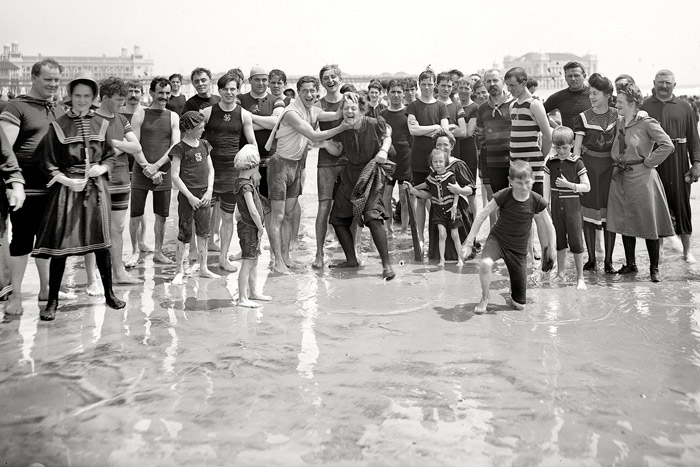
In 1905, when people went to the beach in Atlantic City, New Jersey, they wore funny clothes but had as good a time as beach-goers in 2010.
Many of the vacationers pictured here didn't own their own bathing clothes; they rented them from hotels or boardwalk establishments. If you click on this photo to see the enlarged version, you'll note that some of the bathing costumes are imprinted with the initials of the rental companies.
What about the boy and girl in the middle? Are they flirting? Or is he keeping her from fleeing the picture? Or . . . ?
vintage
beach
New Jersey
Atlantic City
crowd
(Image credit: Detroit Publishing Co., via Shorpy)
Dec 1, 2010
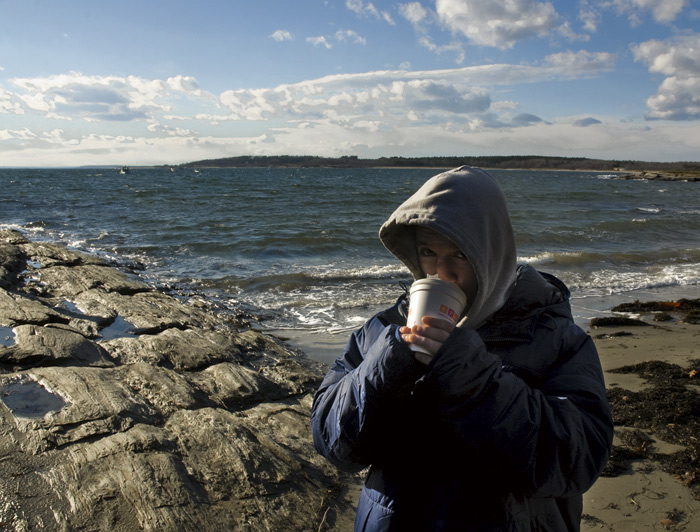
Thanksgiving weekend was seasonably cold in Maine, so sipping coffee was among the smarter things to do at the beach.
beach
Maine
Allen Stein
winter
Kettle Cove
Cape Elizabeth
coffee
Aug 27, 2011
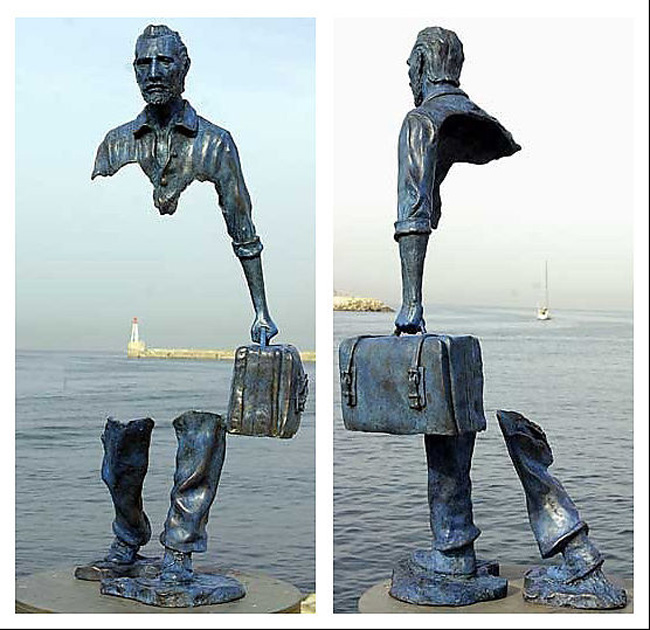
He is "Le Grand Van Gogh," cast in bronze by sculptor Bruno Catalano.
beach
art
sculpture
Bruno Catalano
van Gogh
bronze
holes
Sep 16, 2011
(Image removed at the request of the photographer, Cris Benton)
This view of Drake's Beach at Point Reyes National Seashore in California is another example of kite photography, one of the oldest applications of the photo arts.
During the American Civil War, kites and balloons were used to hoist cameras, and sometimes also cameramen, for spying expeditions. Kite photography was also used to survey the damage after San Francisco's 1906 earthquake and fire.
Planes and satellites, of course, have relegated kite photography to niche status. On the other hand, modern digital cameras and wireless control technology have become so lightweight and inexpensive that it's a readily accessible niche.
beach
birdseye view
California
aerial
kite photography
Point Reyes
Dec 4, 2011
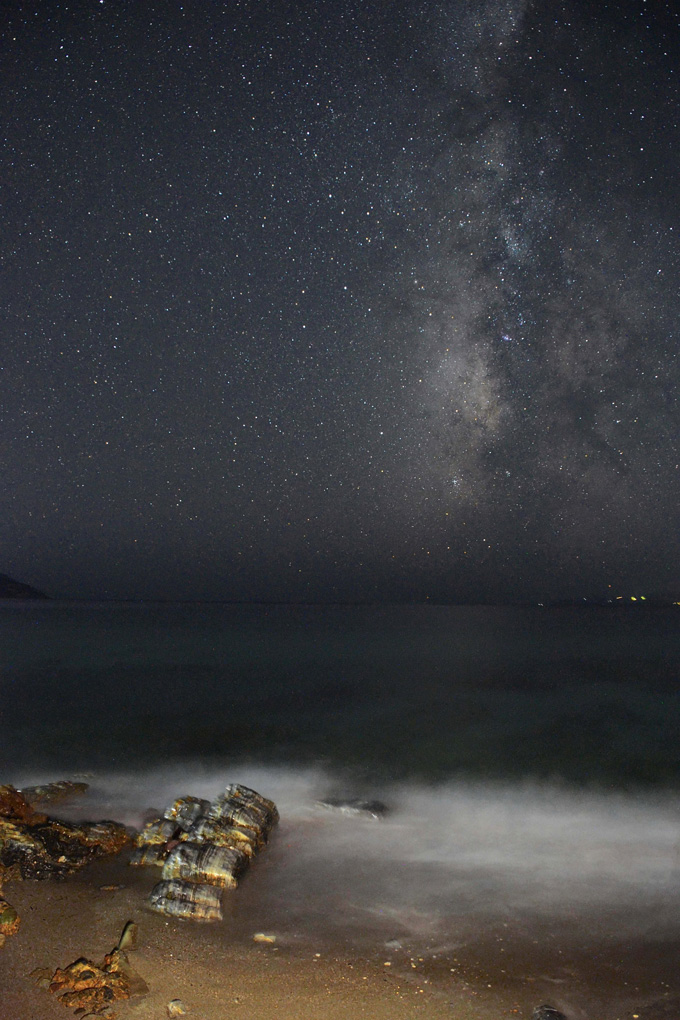
The stars of the Milky Way rise out of the Mediterranean in this time-release photo taken on the beach at the edge of the Greek village of Elia, near Molaoi. The earthly lights in the distance at far right are from the port of Gytheio, a few kilometers away. The brightest part of the Milky Way galaxy, in the right center of the picture near the constellation of Sagittarius, is about 27,000 light-years away.
beach
Greece
Elia
Molaoi
night sky
Gytheio
(Image credit: Stavros Hios)
Jan 7, 2012
 Just another day at the beach, in Australia.
Just another day at the beach, in Australia.
When global warming brings us beach weather in January here in the mid-latitudes of the northern Hemisphere, this particular Australian beach, as well as all our American beaches and those of all the other continents, will be under water. The city of Philadelphia will be under water, along with most of the world's major cities. Oh well. Beaches in West Virginia could be nice.
beach
children
Australia
New Year's
2012
(Image credit:
Jan 17, 2012
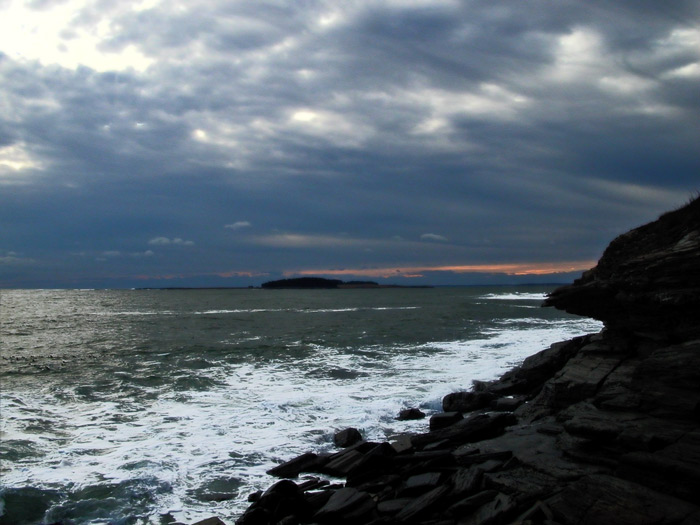 Two winters ago around this time, when this picture was snapped, there was no snow along the southwest coast of Maine, though somehow the color of the water suggested some seriously shivery cold. This year, I understand that there's a bit of snow on the ground in Maine; here in Philadelphia, however, we've had only a flurry or two. It's raining as I type.
Two winters ago around this time, when this picture was snapped, there was no snow along the southwest coast of Maine, though somehow the color of the water suggested some seriously shivery cold. This year, I understand that there's a bit of snow on the ground in Maine; here in Philadelphia, however, we've had only a flurry or two. It's raining as I type.
This stretch of cliff near Kettle Cove in Cape Elizabeth, Maine, faces south more than east, allowing a glimpse of winter sunset over the water.
landscape
beach
Maine
rocks
sunset
Kettle Cove
seascape
Cape Elizabeth
ocean
cliff
Feb 21, 2012
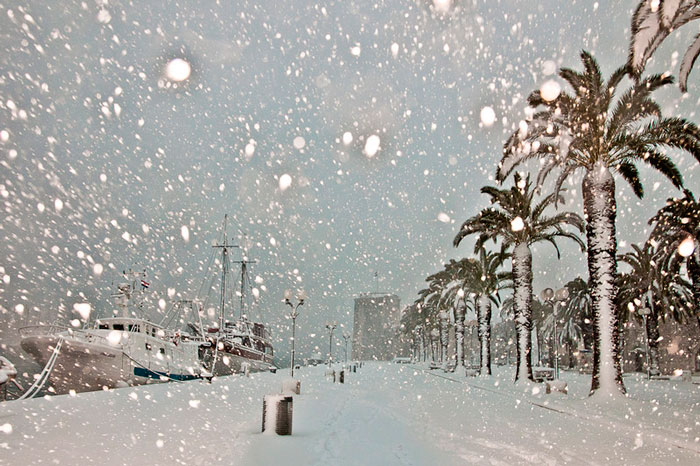 As the vegetation suggests, winter weather is usually a good bit milder than this along the beachfront promenades of the town of Split, on Croatia's Dalmatian Coast. This winter has been particularly cold and snowy throughout much of Europe and even as far south as North Africa; temperatures have bounced back now, however, and this week Split enjoyed sunny afternoons with highs in the upper 50s.
As the vegetation suggests, winter weather is usually a good bit milder than this along the beachfront promenades of the town of Split, on Croatia's Dalmatian Coast. This winter has been particularly cold and snowy throughout much of Europe and even as far south as North Africa; temperatures have bounced back now, however, and this week Split enjoyed sunny afternoons with highs in the upper 50s.
beach
streetscape
winter
weather
climate
palm trees
Split
Croatia
Dalmatian Coast
Jun 14, 2012
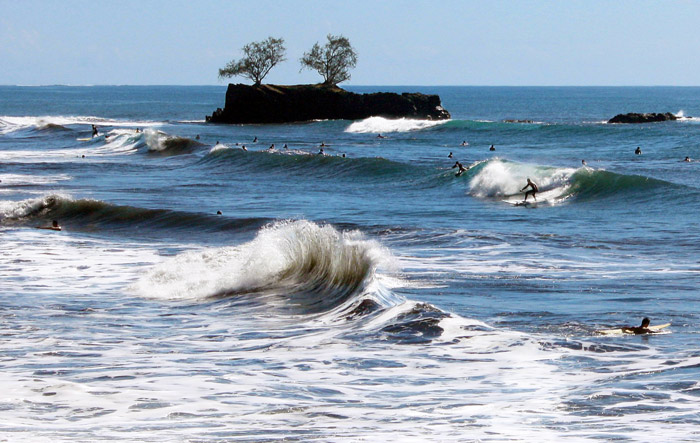 "I send you two pictures of Tahiti," writes my brother, Chuck-the-nuclear-astrophysicist. "Captain Cook was sent to Tahiti to observe the 1769 transit of Venus (Venus passing in front of the sun). He then had secret orders to search for Australia, which he found. I saw the 2012 transit from Point Venus, a beautiful sandy beach on the northwest corner of the Island, where Captain Cook observed the 1769 transit. It was a magical festival with lots of natives.
"I send you two pictures of Tahiti," writes my brother, Chuck-the-nuclear-astrophysicist. "Captain Cook was sent to Tahiti to observe the 1769 transit of Venus (Venus passing in front of the sun). He then had secret orders to search for Australia, which he found. I saw the 2012 transit from Point Venus, a beautiful sandy beach on the northwest corner of the Island, where Captain Cook observed the 1769 transit. It was a magical festival with lots of natives.
"The surfing scene is from the north side of the island not far from Point Venus, while the other picture is from the opposite side of the island, on the south side of the Tahiti Iti peninsula, where the road ends."
Chuck spent a week in Tahiti, doing his scientific thing, and then he had to fly back home so he could get ready for a conference in Italy. It's a tough life, nuclear astrophysics, but somebody's got to do it.
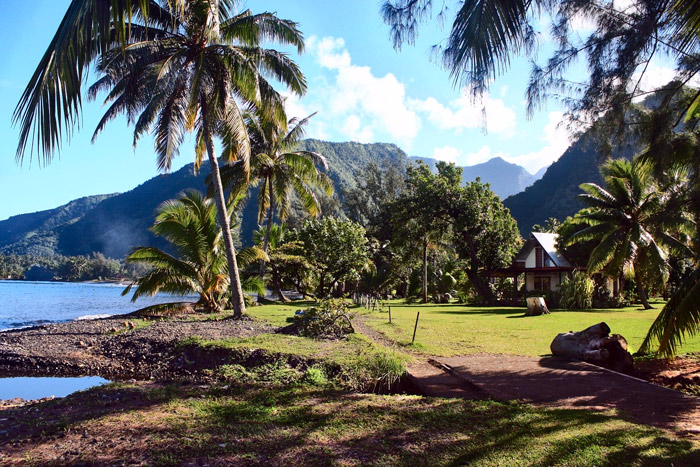
landscape
beach
ocean
Tahiti
Transit of Venus
(Image credit: Charles Horowitz)
Aug 15, 2012

landscape
beach
summer
architecture
sand
beachscape
Aug 3, 2013
 But what's that car doing on the boardwalk?
But what's that car doing on the boardwalk?
beach
streetscape
portrait
couple
hats
(Image credit: lbj1891)
Oct 3, 2013
 Posted on the path to the beach near Aberdeen, Scotland.
Posted on the path to the beach near Aberdeen, Scotland.
beach
signage
Scotland
Aberdeen
(h/t: Carol Fuchs)
Nov 17, 2013
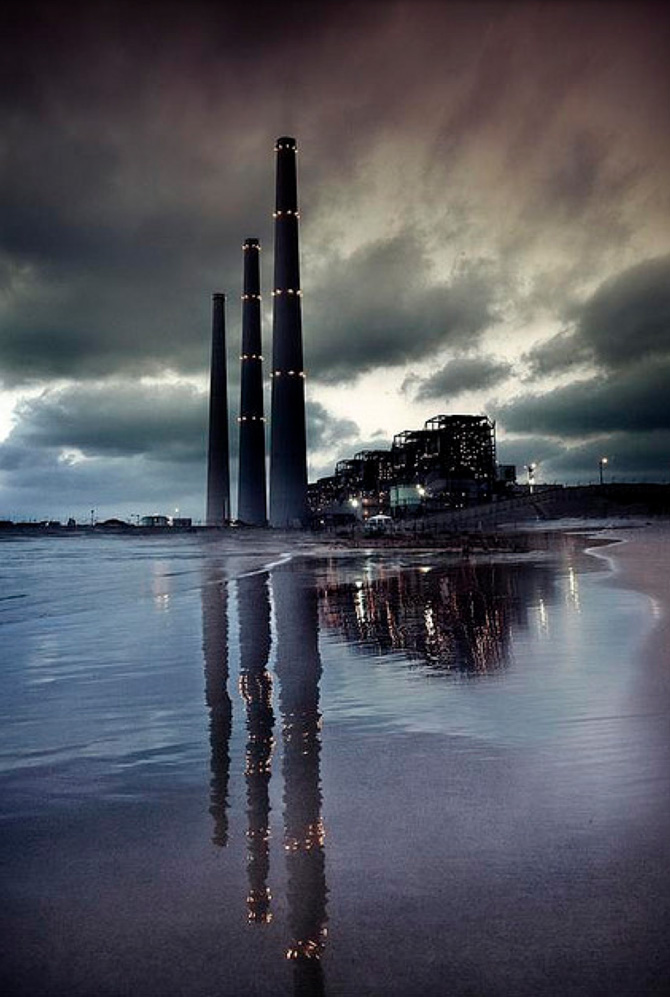 Smokestacks of Israel's largest power plant, Orot Rabin, loom over the beach at Hadera, north of Tel Aviv. The plant's coal-fired turbines produce almost one-quarter of Israel's electricity.
Smokestacks of Israel's largest power plant, Orot Rabin, loom over the beach at Hadera, north of Tel Aviv. The plant's coal-fired turbines produce almost one-quarter of Israel's electricity.
The low structures leading from the chimneys to the left edge of the picture are part of the power station's coal port offshore in the Mediterranean, where ships offload 18,000 tons of coal every day.
The plant is called Orot Rabin–Rabin Lights–in remembrance of Israeli President Yitzhak Rabin, who was assassinated in 1995. Electricity generated here lights much of the country, producing something like the memorial lights of Jewish tradition, helping to keep alive the memory of those who are gone.
landscape
beach
clouds
Mediterranean
industry
reflection
electricity
coal-powered
Hadera
Israel
power plant
(Image credit: Gilad Benari)
Jul 21, 2014

At the north end of Castlepoint sheep station is Castle Rock itself, noted and named in the eighteenth century by Captain Cook. The rock anchors one end of a limestone reef; on the headland at the other end is Castlepoint Lighthouse, built in 1913, originally fueled by oil but now wired into the grid and controlled from a switchboard in Wellington, a couple of hours away. Its light is visible 22 miles out at sea.
The postage stamp above dates from 1947. For almost a century beginning in the 1890s, the New Zealand government operated a life insurance company that had government franking privileges and printed its own stamps. Lighthouses were nineteenth-century symbols for insurance companies (as were big rocks, e.g., Mutual of Omaha). The government sold off its insurance operations in the 1980s, to a corporation doing business as Tower Life of Dunedin, New Zealand.
The reef at Castlepoint is not at all like the coral reefs growing placidly around tropical lagoons; geologically, it's a chunk of ancient seafloor millions of years old heaved up violently during seismic activity associated with the collision of the Pacific and Australian tectonic plates.
The limestone in the reef is richly fossiliferous, and directly underneath the lighthouse it's pocked with caves.
Inside the reef is a lagoon and a wide, hard-sand beach, crucial features in the development of a large sheep station here, back in the days before highways. Since the coast in this region has no natural harbors, sheepmen used to drive wagonloads of wool bales down the beach, to be loaded at water's edge into small boats that ventured out at high tide to meet up with cargo ships waiting offshore.
Today, shipping activity at Castlepoint is mostly recreational in nature, and the hard-packed beach now serves tractors and boat trailers. The blue tractor in the picture below is driverless and remote controlled from the boat, where the captain calls for it to push an empty trailer down into the surf and then pull the loaded trailer back up to high ground.
In the picture below, the tiny figure walking the beach near water's edge is my mother-in-law.
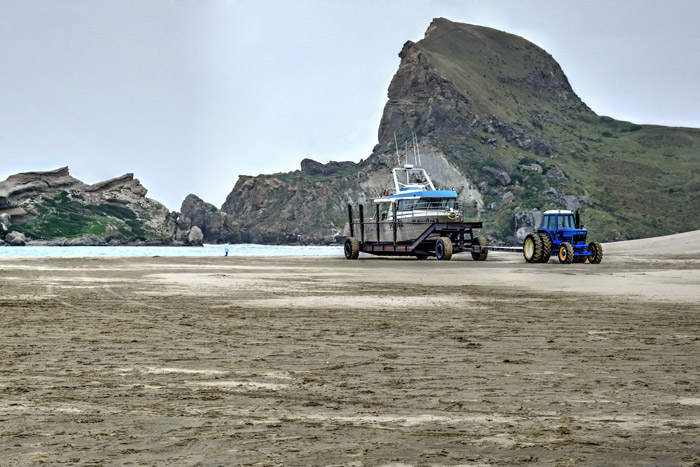
beach
sheep
New Zealand
geology
rock
Pacific Ocean
history
Wairarapa
lighthouse
(Image credit: Little Fuji [lower photo])
Jan 4, 2015
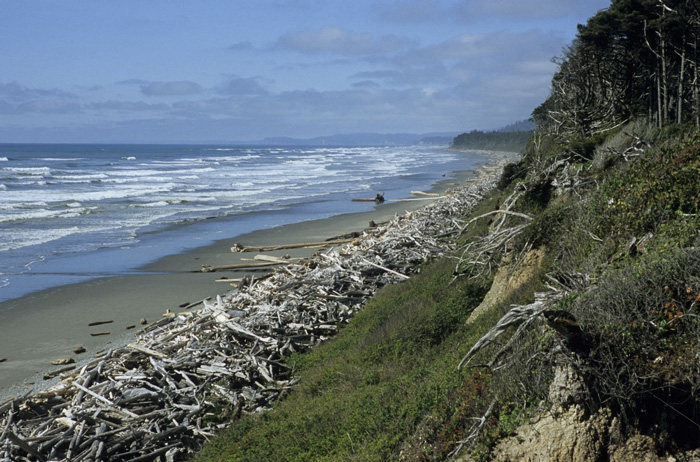 Pacific Ocean beach near Kalaloch, in Olympic National Park.
Pacific Ocean beach near Kalaloch, in Olympic National Park.
Driftwood arrives naturally on beaches in the Pacific Northwest; storms, erosion, and ordinary old age can cause trees growing in thin soil on steep slopes to tumble down into inland creeks and rivers; when the rivers are running high and fast, entire forests can be floated right on out to the coast.
Washington
landscape
beach
Pacific Ocean
driftwood
Olympic National Park
Kalaloch
(Image credit: singletrack.com)
Jan 23, 2015
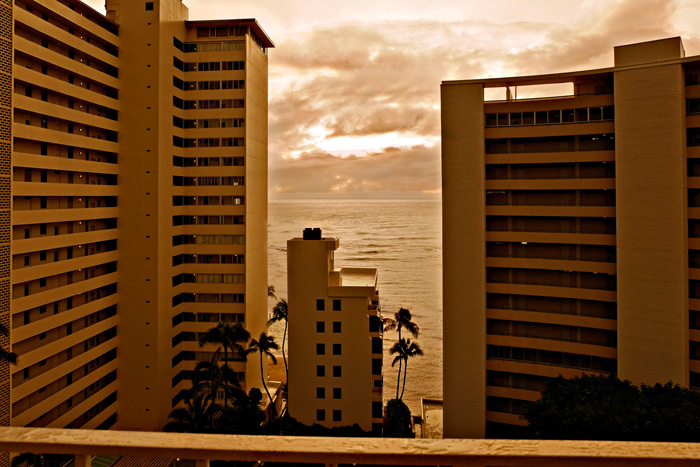 Waikiki
Waikiki
beach
cityscape
sunset
sky
skyline
palm trees
Hawaii
Honolulu
(Image credit: Little Fuji)
Feb 17, 2016
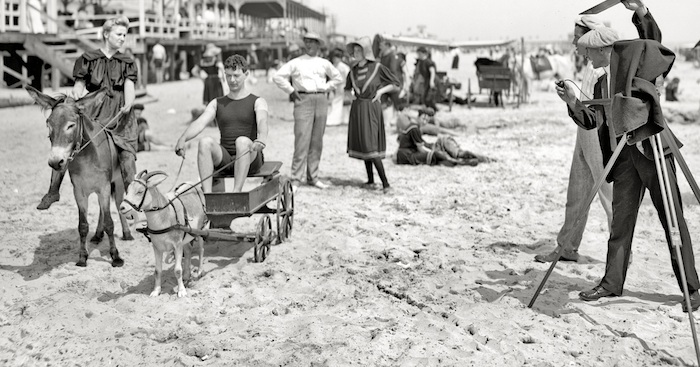
They were newlyweds in 1905, honeymooning at the beach in St. Augustine, Florida, when they came across the photographer and his props in the sand. And they decided to get their picture made.
So the bride, in her bathing costume, straddled the donkey. And the groom, in his own bathing garb, settled himself onto the seat of the little wagon hitched up to the goat. The props were obviously intended for small children, but the newlyweds were game, even if they didn't look one bit happy about it all.
beach
1905
Florida
wagon
photography
donkeym goat
St. Augustine
(Image credit: Detroit Publishing Company via Shorpy)
May 26, 2016
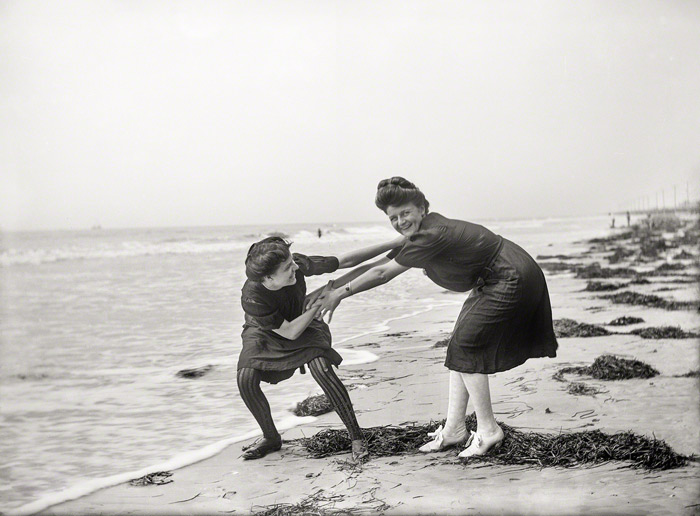
beach
bathing costumes
(Image credit: Detroit Publishing Co via Shorpy)
Jan 6, 2017
 These four words were scratched into the sand at one end of the beach in Ecola State Park, near Cannon Beach, Oregon. The love note was inscribed at the other end of the beach.
These four words were scratched into the sand at one end of the beach in Ecola State Park, near Cannon Beach, Oregon. The love note was inscribed at the other end of the beach.
But they go together, right? Maybe Summer Liver loves Sky Melodee? That's probably not right, but somehow these two messages have got to fit together?

beach
Oregon
graffiti
sand
Ecola State Park
Cannon Beach
(Image credit: Little Fuji)
Jan 29, 2017
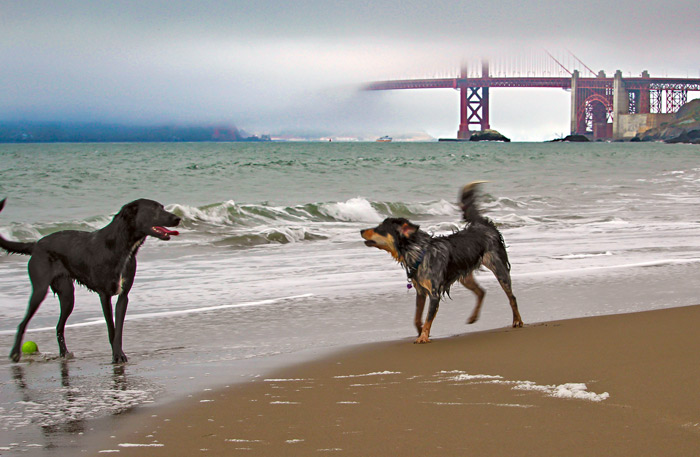 That's a couple of wet dogs goofing it up, out there by the Golden Gate Bridge. Zoe, at left, lived in San Francisco until recently, when her boy Patrick moved to Seattle. Hank's pup Mabel visited with Zoe last June and now shares a house in Seattle with her and some other critters.
That's a couple of wet dogs goofing it up, out there by the Golden Gate Bridge. Zoe, at left, lived in San Francisco until recently, when her boy Patrick moved to Seattle. Hank's pup Mabel visited with Zoe last June and now shares a house in Seattle with her and some other critters.
beach
San Francisco
dogs
Mabel
Golden Gate Bridge
Zoe
(Image credit: Hank Stein)












 As the vegetation suggests, winter weather is usually a good bit milder than this along the beachfront promenades of the town of Split, on Croatia's Dalmatian Coast. This winter has been particularly cold and snowy throughout much of Europe and even as far south as North Africa; temperatures have bounced back now, however, and this week Split enjoyed sunny afternoons with highs in the upper 50s.
As the vegetation suggests, winter weather is usually a good bit milder than this along the beachfront promenades of the town of Split, on Croatia's Dalmatian Coast. This winter has been particularly cold and snowy throughout much of Europe and even as far south as North Africa; temperatures have bounced back now, however, and this week Split enjoyed sunny afternoons with highs in the upper 50s.



 Posted on the path to the beach near Aberdeen, Scotland.
Posted on the path to the beach near Aberdeen, Scotland.






 These four words were scratched into the sand at one end of the beach in Ecola State Park, near Cannon Beach, Oregon. The love note was inscribed at the other end of the beach.
These four words were scratched into the sand at one end of the beach in Ecola State Park, near Cannon Beach, Oregon. The love note was inscribed at the other end of the beach.
